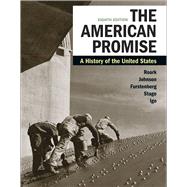The American Promise has long been a course favorite for its readability, clear chronology, and the voices of Americans that animate the book. Now with new co-authors, the eighth edition continues to deliver a strong narrative with political backbone and offers a new pedagogical design that reinforces that history is a discipline rooted in debate and inquiry. The American Promise has primary sources in each chapter, a full-color map and art program, and comprehensive supplement options, including LaunchPad and a free companion sourcebook.
Available for free when packaged with the print book, the popular digital assignment and assessment options for this text bring skill building and assessment to a more highly effective level. The greatest active learning options come in LaunchPad, which combines an accessible e-book with LearningCurve, an adaptive and automatically graded learning tool that—when assigned—helps ensure students read the book; the complete companion reader with comparative questions that help students build arguments from those sources; and many other study and assessment tools. For instructors who want the easiest and most affordable way to ensure students come to class prepared Achieve Read & Practice pairs LearningCurve, adaptive quizzing and our mobile, accessible Value Edition e-book, in one easy-to-use product.








